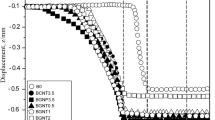Abstract
Boron-doped carbon-carbon composites with boron concentration around 11–15 mass % were prepared from a carbon fibre felt with dispersed boron carbide powder by infiltration of pyrolytic carbon. The composite was heat treated at several different temperatures from 2000–2800 °C. The highest bending strength was obtained for the composite at a heat treatment temperature (HTT) of 2200 °C. Carbon fibre began to be destroyed after heat treatment at 2400 °C and the structure of the composite was drastically changed above 2600 °C where the anisotropy of the composite originally existing in the thermal expansion coefficient and the thermal conductivity has been faded away. X-ray diffraction measurement indicated that graphitization of the composite was enhanced by boron doping. At HTTs above 2400 °C, the composite became graphitic, the crystallite sizes of which were more than 100 nm in Lc (004) and La (110). It was shown that boron was uniformly distributed in the composite at an HTT of 2400 °C and also that heat treatment at higher temperatures, such as 2600 °C, incurred condensation of boron. Air-oxidation loss at 800 °C appeared to be the lowest for the composite with an HTT of 2400 °C and the rate of oxidation loss was 22 times lower than that of the non-boron-doped composite.
Similar content being viewed by others
References
A. C. Titus, in “Proceedings of Forth Conference on Carbon”, edited by S. Mrozowski, M. L. Studebaker and P. L. Walker, Jr. (Pergamon Press, Oxford 1960) New York (1959) p. 703.
C. E. Lowell, J. Am. Ceram. Soc. 50 (1967) 142.
R. E. Woodley, Carbon 6 (1968) 617.
R. B. Trask, Fuel 47 (1968) 397.
D. J. Allardice and P. L. Walker Jr, Carbon 8 (1970) 375.
H. N. Murty, D. L. Biederman and E.A. Heintz, Fuel 56 (1977) 305.
A. Ōya, R. Yamashita and S. Ōtani, ibid. 58 (1979) 495.
K. Miyazaki, K. Kobayashi and H. Honda, Tanso 1977 (sn91) (1977) 121.
R. A. Murgatroyd and B. T. Kelly, Atom. Energy Rev. 15 (1977) 1.
K. Fujii, S. Nomura, H. Imai and S. Shindo, in “Proceedings of a Specialists' Meeting”, Tokai-mura, Japan, 9–12 September 1991, edited and published by International Atomic Energy Agency (IAEA) Wien, IAEA-TECDOC-690, pp. 169–76.
H. Matsuo, F. Kobayashi and K. Sawa, Tanso 1993 (sn159) (1993) 185.
Y. Hirooka, R. W. Conn, R. Causey, D. Croessmann, R. Doerner, D. Holland, M. Khandagle, T. Matsuda, G. Smolik, T. Sogabe, J. Whitley and K. Wilson, J. Nucl. Mater. 176, 177 (1990) 473.
T. Hino, M. Hashiba, K. Akimoto and T. Yamashina, J. Nucl. Sci. Technol. 28 (1991) 20.
Y. Hirooka, R. W. Conn, M. Khandagle, G. Chevalier, T. Sogabe, T. Matsuda, H. Ogura, H. Toyoda and H. Sugai, Fusion Technol. 19 (1991) 2059.
T. Hino and T. Yamashina, J. Nucl. Mater. 196–198 (1992) 531.
T. Hino, K. Ishio, Y. Hirohata, T. Yamashina, T. Sogabe, M. Okada and K. Kuroda, ibid. 211 (1994) 30.
I. Fujita, T. Hino, T. Yamashina, Y. Kubota, A. Sagara, N. Noda, O. Motojima, T. Matsuda, T. Sogabe, M. Okada and K. Kuroda, J. Nucl. Mater. 220–222 (1995) 795.
K. Miyazaki, T. Hagio and K. Kobayashi, Yougyo-Kyoukai-Shi 86 (1978) 618.
K. Miyazaki, T. Hagio and K. Kobayashi, J. Mater. Sci. 16 (1981) 752.
T. Sogabe, T. Matsuda, K. Kuroda, Y. Hirohata, T. Hino and T. Yamashina, Carbon 33 (1995) 1783.
Y. Nakajima, I. Sakamoto, K. Kobayashi, Y. Uchiyama and H. M. Cheng, in “Proceedings of 19th Annual Meetings of Carbon Society of Japan”, edited and published by The Carbon Society of Japan in Tokyo, 1992, Kyoto (1992) pp. 260–1.
S. Ragan and G.T. Emmerson, Carbon 30 (1992) 339.
M. Inagaki, in “Tanso-zairyou-jikken-gijyutsu”, edited by The Carbon Society of Japan (Kagakugijyutsu-sha, Tokyo, 1978) p. 55.
T. Hagio, M. Nakamizo and K. Kobayashi, Carbon 27 (1989) 259.
R. M. Bushong and E. A. Neel, in “Proceedings of 5th Conference on Carbon”, edited by S. Mrozowski, M. L. Studebaker and P. L. Walker Jr. (Pergamon Press, Oxford) Pennsylvania 1 (1961) pp. 595–9.
S. Marinković, in “Chemistry and Physics of Carbon”, Vol. 19, edited by P. A. Thrower (Marcel Dekker, New York, 1984) p. 1.
Author information
Authors and Affiliations
Rights and permissions
About this article
Cite this article
Sogabe, T., Nakajima, K. & Inagaki, M. Effect of boron-doping on structure and some properties of carbon-carbon composite. JOURNAL OF MATERIALS SCIENCE 31, 6469–6476 (1996). https://doi.org/10.1007/BF00356250
Received:
Accepted:
Published:
Issue Date:
DOI: https://doi.org/10.1007/BF00356250




